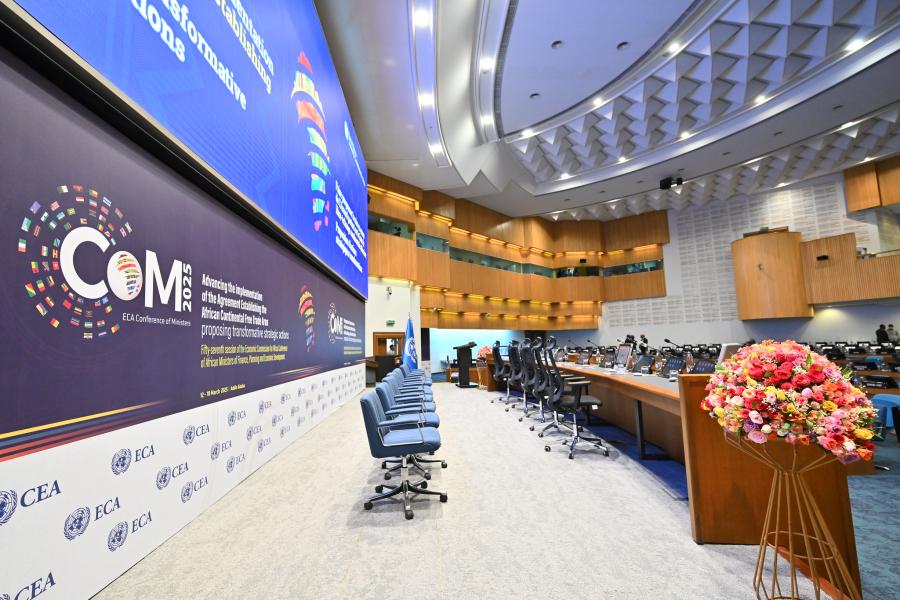Addressing Climate Finance for African MICs: A Holistic Approach to Sustainable Development
 CoM UNECA 2025
CoM UNECA 2025
Etienne Espagne, C3A Program co-Director, was invited to the 57th session of CoM UNECA (Conference of Ministers of the Economic Commission for Africa) - in Addis-Ababa to participate in a side-event on March 14th. This event provided an important platform to discuss the role of climate finance in supporting African middle-income countries (MICs) as they navigate the challenges of climate change and mounting debt vulnerabilities. Here are some key takeaways of these discussions:
The Role of Ministries of Finance in financing the transition
Participants recognized that Ministries of Finance play a central role in determining how climate finance is deployed in African MICs. While the focus often centers on calculating the required investments to achieve climate resilience or net-zero targets, Ministries of Finance must address more specific questions: What financing strategies are best suited to a country’s unique structure and exposure to climate risks? How can private investment be attracted in order to prevent a large increase in public debt ratios? In that sense, participants highlighted that a holistic, analytical approach is needed to assess the macro-fiscal impacts of climate finance. This involves evaluating a range of risks, including currency fluctuations, interest rates, and political instability. For example, green investments can increase imports and depreciate the local currency, especially in fossil fuel-exporting countries. To mitigate this, countries can develop local green supply chains or implement currency hedging solutions, which help reduce risks and ensure a more sustainable financing path.
Innovative Instruments: From Brazil to Africa
The example of Brazil’s Eco Invest program has been presented during the side-event. It offers an example of possible financial arrangements to manage climate finance risks. Structured within Brazil's Fundo Clima, Eco Invest aims to reduce capital costs and enhance foreign exchange (FX) liquidity for local companies investing in green projects. The program utilizes a multi-faceted approach: Blended finance facilities that provide concessional funding in local currency, foreign exchange liquidity facilities to manage FX risk, and FX derivatives that link international capital markets to local financial institutions. This innovative financing structure can be inspiring to African MICs Ministries of Finance who would like to simultaneously overcome limitations of local financial markets, improve liquidity, and reduce borrowing volatility, all without exacerbating debt burdens.
The C3A African Hub: Building financing strategies to navigate the ecological transition
The side-event was also an opportunity to present the the C3A African Hub. In partnership with the United Nations Economic Commission for Africa (UNECA) and the Ministry of Finance of Uganda, the C3A African Hub has initiated activities to support African countries in strengthening their climate finance capabilities, allowing them to leverage innovative financial instruments to enhance resilience to climate risks.
In the coming months, C3A, UNECA and the Ministry of Finance of Uganda will enhance their partnership following a common strategy which includes joint research initiatives covering the specific challenges faced by African MICs and LICs in the ecological transition, capacity building activities ensuring widespread understanding of climate-related risks and opportunities, and peer exchange at policy and technical levels to continuously adapt financing strategies and address emerging issues.
Key thematic priorities
Based on outcomes of an extensive stakeholder consultation carried out by C3A, UNECA and the CFMCA with African partners, several priority areas emerged as pivotal for enabling African MoFs to advance climate-resilient economic policies. These priorities will be the backbone of the C3A African hub thematic framework:
- Debt and financing strategies: Several African countries face the challenge of simultaneously addressing financial sustainability, investing in low-carbon and resilient transitions, and supporting national and global development goals. In an uncertain and constrained international financial context, these three policy objectives are ever more difficult to reconcile. Designing financing strategies that align short, mid-and long-term objectives, while leveraging opportunities from the low-carbon and resilient transition becomes a strategic policy objective;
- Emerging green supply-chains, and green industrial policies and associated macroeconomic policies: The low-carbon and resilient transition implies a complex and multidimensional structural transformation of the economy. It entails both challenges and opportunities that can be addressed and supported through economic policy instruments. Opportunities such as integration into new green supply chains, job transitions and skills development, and the sustainable use of critical minerals resources can play a significant role;
- Adaptation and economic resilience: Given that several African countries are particularly vulnerable to extreme weather events, and heavily reliant on the agriculture sector for both exports and subsistence, adapting to climate change is this sector - as well as in energy, infrastructures and housing for instance - is a critical component of a comprehensive development strategy.
